|
-
12th July 12, 09:42 AM
#11
I am fairly sure I have seen black watch with a red and yellow stripe added - as an overcheck.
I have bought tartan which was described as Black Watch and turned out to be Semple - with a red and white overcheck but I think only half the Black Watch set.
Anne the Pleater :ootd:
-
-
13th July 12, 04:04 AM
#12
Black Watch with yellow stripe on green = Gordon.

Black Watch with white stripe on green = Lamont or Forbes

(Forbes is woven today with black guards on the white stripe)
Black Watch with red stripes = Murray of Atholl

Black Watch with red & white stripes may be MacKenzie or Robertson Hunting, depending on the arrangement of the stripes. MacKenzie has the white on the green.

While Robertson has the white on the blue.
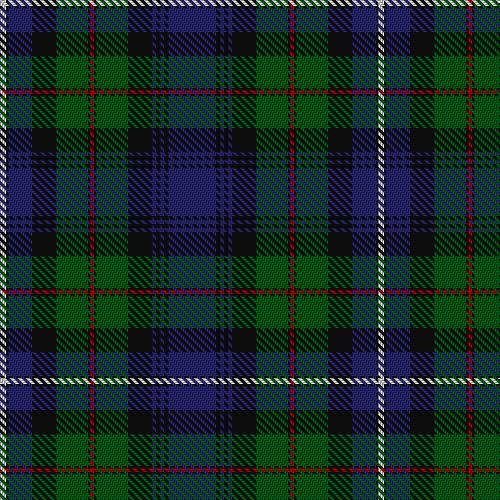
Other Black Watch variants include...
Baillie:
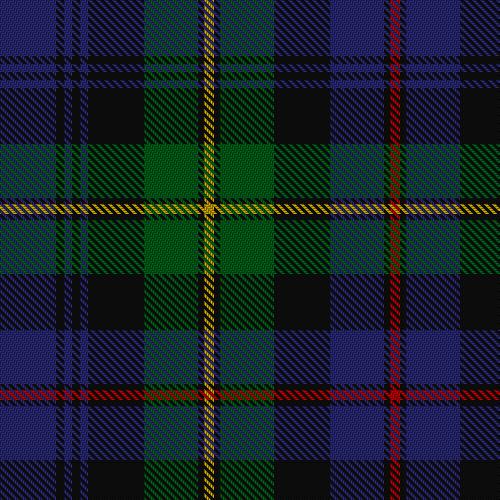
Farquharson:
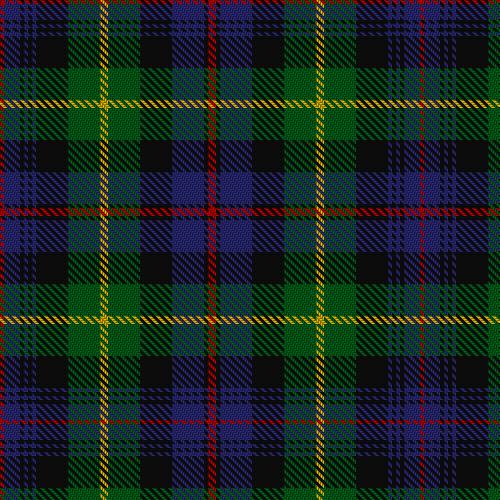
MacLachlan:

MacNab:
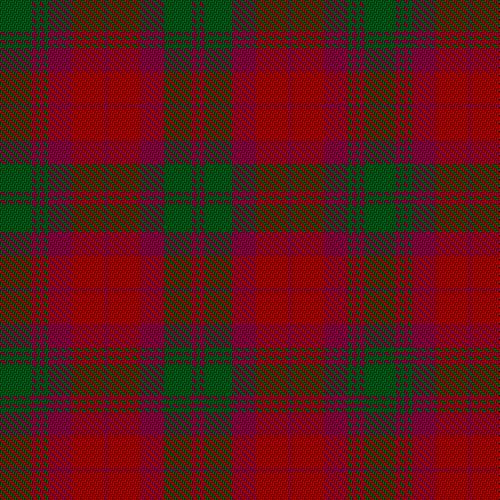
There are many others! (Images courtesy of the National Tartan Register).
-
-
13th July 12, 04:20 AM
#13
 Originally Posted by David Thorpe

I have seen the Red Hackle tartan which is the Black Watch with a thin red stripe. Are there others with this feature? I know that there are many adaptations of Black Watch with various stripes added and/or color substitutions. Could Black Watch be the most "prolific" tartan ever in that respect?
I'd be interested in seeing what Mr. Newsome has to offer as to the prolific nature of the Black Watch tartan. I also wonder if Royal Stewart isn't in the same boat.
Gu d¨bhlanach
Coinneach Mac Dh˛mhnaill
-
-
13th July 12, 04:35 AM
#14
Thanks, Matt. Very clearly done!
-
-
14th July 12, 04:06 AM
#15
Great illustrations there Matt.
Donald C Stewart has a great discussion of all these Black Watch variants and the murky origins of the Black Watch tartan in The Setts of the Scottish Tartans.
One interesting thing is the MacRae fragment which, if actually dating to 1715, predates the Black Watch.
"While several of this group of tartans, such as Gordon and Forbes, are acknowledged to be variants of the Black Watch, there are other with claims to greater antiquity not lightly to be dismissed...
Whatever doubts may exist concerting the antiquity of those tartans that more obviously share the Black Watch basis, there can be none about the Royal Stuart, and if we isolate the black portions of this, we can see that the Royal Stuart itself may have been the source- and it is a probable one- from with the Black Watch was directly derived, though it is not the only possible souce."
and
"The Grants and Muroes both now use the Black Watch tartan for undress, but members of these clans, along with several Campbells, were in 1729 commanders of independent companies that later went to form the regiment. In a collection made about 1815 the same design, in four different sizes, is variously denominated Sutherland, Campbell, Munro, Grant, Black Watch, and Government."
Last edited by OC Richard; 14th July 12 at 04:07 AM.
Proud Mountaineer from the Highlands of West Virginia; son of the Revolution and Civil War; first Europeans on the Guyandotte
-
-
14th July 12, 04:51 AM
#16
Richard,
I would heartily recommend James Scarlett's more recent book, The Origins and Development of Military Tartans, which was published in 2003, as a source for the latest thinking about the origins of the Black Watch tartan in particular, and military tartans in general. D. C. Stewart wrote in 1950 and did not have access to much of the evidence and resources that Scarlett did.
The MacRae tartan which Stewart is referring to is this one:
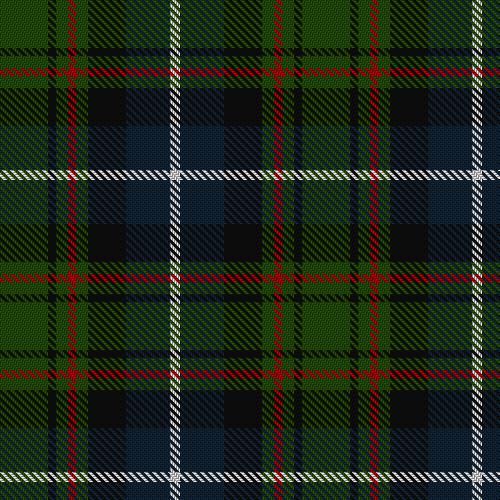
It was published originally in 1893 in Old & Rare Scottish Tartans, by D. C. Stewart's father, D. W. Stewart. In that reference the author claims this tartan to be based on a fragment of a kilt worn at the Battle of Seriffmuir in 1715. I do not know what D. W. Stewart's evidence for this was (Peter, do you?) but it must be remembered that none of us are infallible when it comes to tartan. Consider how incorrectly he depicted the so-called "Culloden tartan" in his book.
Wilsons' version of the MacRae tartan shows a much greater resemblance to the Black Watch design.
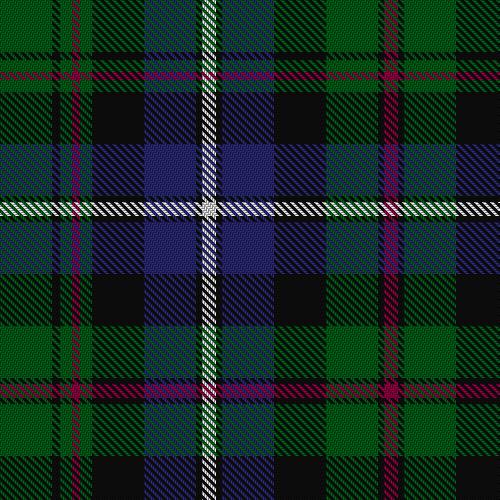
This is from a sample dated 1820. If you look, you will see that the version D. W. Stewart gives is effectively half the sett of the Wilson's version. If indeed his tartan is based on a "fragment of a kilt" it could be that he did not have the entire sett available. Or it could be that the MacRae tartan began as a simple design and later was changed to the more complex sett (which indeed is what happened to the Black Watch tartan itself). Of course it is just as possible that the MacRae began life as a variation on the Black Watch and the simpler sett was introduced at a later time as a variant of that, and D. W. had his information wrong.
James Scarlett has this to say in his reference:
Plate No XXVII in Old and Rare Scottish Tartans, subsequently named Hunting MacRae... [is] curtailed from the full Black Watch sett, pivoting on, what would have been in the original, the blue square with doubletracking and the black line centred on the green. In respect to the Black Watch, MacRae has blue and green transposed... Wilsons' made a full-length version of MacRae, with a rose overcheck on the second green and so revealing it to be a transposition of the Seaforth tartan...
If the Black Watch is indeed an end product dating from 1749 or even 1739, D. W. Stewart's MacRae cannot have been worn at Sheriffmuir in 1715, but that is of no great import in the present context. What matters is whether [this tartan is a] further example of [a] government pattern. The historical connection between the Mackenzies and the Macraes and the clever allusion contrived by the tartans suggests that they may well be.
-
-
14th July 12, 04:59 AM
#17
 Originally Posted by KenB

I'd be interested in seeing what Mr. Newsome has to offer as to the prolific nature of the Black Watch tartan. I also wonder if Royal Stewart isn't in the same boat.
Certainly the Royal Stewart motif is repeated quite often, but not quite as prolifically as the Black Watch, and for different reasons. Many of the popular color variations of the Royal Stewart tartan retain the name Stewart (Dress Stewart, Black Stewart, Dress Blue Stewart, Camel Stewart, etc.). Others do not, such as Clodagh and Macbeth, but the origins of many of these lie in the fashion world rather than with the military or the clans themselves. There are a few so-called "Irish family" tartans that are simple color changes from the Royal Stewart, such as O'Farrell and Shaughnessy. I can imagine a weaver getting an request for a non-existing Irish name tartan and simply creating one to order by changing the colors of a preexisting tartan. (The popular Tara tartan is simply a color change of MacLean of Duart).
The many Black Watch variations were done with specific purpose in order to identify a particular military regiment, and in most cases these were later adopted by the clans. So we have tartan created for the Gordon Highlanders now regarded as the Gordon clan tartan. The tartan worn by the Seaforth Highlanders is now the MacKenzie clan tartan. The tartan designed for the Loyal Clan Donnachaidh Volunteers is now the Hunting Roberston tartan. Even the Black Watch tartan itself has been adopted by the clans Campbell, Munro, and Grant.
-
-
14th July 12, 05:04 AM
#18
PS -- here is the actual plate from Old and Rare Scottish Tartans depicting the MacRae Hunting.

From: http://resources.scottishtartans.org...e_gallery.html
-
-
28th July 12, 01:00 AM
#19
With reference to the question of any black watch tartans with red stripe there is one I know of, the New South Wales Scottish Rifles who wore the black watch tartan with a red stripe through it. I recall seeing a painting of the Battle of Waterloo once where highlanders were represented with kilts that looked like black watch with a red stripe not sure if that was an artist 's interpretation but rest of the painting looked like it was trying to be an accurate representation ( not that the NSW Scottish were there in 1815!) There is a reference in the Scottish Register of tartans to this tartan (STWR ref: 226) and I think the NSW highland pipes band wore this tartan when they attended Edinburgh a year or so ago. NSW Scottish Rifles later morphed into the NSW Scottish Regiment who were allowed to wear the black watch tartan , but without the hackle.

Last edited by Grae; 30th July 12 at 11:16 PM.
Reason: photo
Kilt on with Confidence
-
-
28th July 12, 09:53 AM
#20
I hear references to books are there military or government records or the family records of the men who raised them or their agents ..does it tell who wove the plaids or where they were gotten from ..the contractor that furnished them specifically anywhere at all ? Who were the ones in the 1700's if they are known ??
th
d
-
 Posting Permissions
Posting Permissions
- You may not post new threads
- You may not post replies
- You may not post attachments
- You may not edit your posts
-
Forum Rules
|
|





















Bookmarks